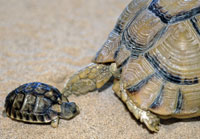Bonus content from the September 2010 REPTILES magazine article "Exotic Egyptians."
Egyptian tortoises (Testudo kleinmanni) reach a breeding size at 3 inches for the males and 4 inches for the females. This is a minimum size, especially where the female is concerned. It is a relatively common problem for Egyptian tortoises to be bred at too small of a size. This can lead to problems with the egg being retained, also called “egg bound.” The egg can either stay lodged because it is too large to pass, or the egg can rupture. Either of these conditions can lead to the death of the female. This is why it is suggested to either keep a close eye on a pair, or keep the pair separated until the female is at least 5 inches in length.
Click image to enlarge Egyptian tortoise (Testudo kleinmanni) hatchlings are delicate and require special attention to environmental controls. Photo by E.J. Pirog. |
Breeding Egyptian tortoises in captivity takes place at any time of the year, depending on the seasonal cycle the keeper chooses. It usually takes place after a winter cool down or created dry season. For most collections, this usually occurs in the spring near the month of April, because the indoor seasonal cycle frequently corresponds with the outdoor cycle. The season typically ends around the month of September. In this cycle, you can expect breeding from April to September, with nesting beginning in the month of July. Nesting usually ends by the end of December. This cycle can shift, depending on the actual conditions under which the group is kept.
The Egyptian tortoise is capable of being an extremely prolific tortoise. A female can nest up to seven or more times a year, with anywhere from one to five eggs deposited at each nesting, but typically a female will only nest two or three times a year with one to two eggs being deposited a nesting. Clutch size seems to correlate to egg size. It appears that the larger the eggs, the smaller the clutch, and the smaller the eggs, the larger the clutch.
A nesting female Egyptian tortoise will constantly pace when she is ready to deposit eggs. The easiest method to deal with this is to already have a substrate, such as a sand and soil mixture or a sand substrate alone, deep enough to nest. Substrate does not have to be more than 5 or 6 inches deep. Another method is to have a separate nesting box prepared. This does not have to be anything more than a large plastic container measuring 2 feet long and 1 foot wide with slightly moistened sand or soil. Adding shredded newspaper seems to add security, which aids in egg deposition.
It if the Egyptian tortoise is ready to nest, this is usually accomplished within a half hour to an hour. If you are watching the tortoise nest, it is easiest to remove the eggs by waiting until she begins to cover the eggs and then move the tortoise off the nest. When they are nesting, they go into a kind of trance. The eggs can be removed from the nest, and the tortoise can be replaced on the nest, where she will continue covering the nest.
Most breeders remove the Egyptian tortoise eggs from the nest to artificial incubators. Eggs are incubated at a temperature of 82 to 88 degrees Fahrenheit. It is believed that the lower temperatures produce males and the upper temperatures produces females, with the crossover temperature of 86 degrees producing both males and females. The temperature will also determine at how long the eggs will take to develop and hatch. The lower the temperature, the longer it takes for the eggs to hatch. The higher temperature, the less time it takes. The keeper needs to be careful to note that too high of a temperature does increase the chance of deformities, from anything as minor as added scutes to missing or multiple appendages. At the temperature range given, the eggs will hatch somewhere between 85 to 126 days, with an average of 94 days, but this can vary further depending on the individuals.
When it gets close to hatching day, the Egyptian tortoise inside the egg will scratch the inner membrane with their claws and egg tooth, which break the integrity of the egg. This causes the egg to take on a mottled looked. It goes from pure white to splotchy shades of white. Within hours to a day or so, the tortoise usually pips or puts a small hole in the egg. The tortoise should remain in the egg until it completely emerges on its own. It needs time to completely absorb the remaining yolk sac, which is attached to it underneath.
Once the Egyptian tortoise emerges, they are usually folded in the mid section. The tortoise should be placed in a small container with moistened paper towel, tissue or cloth until the shell straitens out, which usually takes a few days. A week after it has absorbed the yolk sac, set the hatchling up in an enclosure. The newly hatched tortoise may not begin feeding up to a month after the yolk sac is absorbed.
Want to read the full story? Pick up the September 2010 issue of REPTILES, or subscribe to get 12 months of articles just like this.

